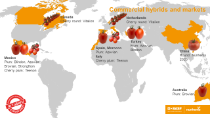Media
Fighting viruses by innovative breeding
Viruses, such as the Coronavirus, have a serious impact on our lives. But viruses not only threaten humans, they also threaten plants – including those we eat. Viruses can be transmitted from one plant to another and although such viruses do not harm people, they can wreak havoc on a crop, significantly reducing yields. The Tomato Brown Rugose Virus (ToBRFV) is one of the biggest threats for growing tomatoes.
Did you know your favorite cherry tomato or sandwich slicer may be a different variety from one year to the next? That’s because fruit and vegetable varieties are constantly being improved. Such improvements include for example easier growing, improved yield, better taste, a longer shelf-life and other important characteristics.
In addition to these enhancements, breeders must also take into account threats such as viruses. Vegetables are threatened by viruses which can destroy an entire season’s crop. These viruses arise suddenly and spread quickly, damaging the availability of produce for consumers, and threatening the livelihood of farmers. To avoid losing a crop, immediate, swift action is required.
For tomatoes, there is one virus that is particularly aggressive and difficult to control: the Tomato Brown Rugose Fruit Virus (ToBRFV). This virus causes grainy yellowing and bulging on the leaves, damages fruit, and can quickly spread throughout a tomato crop. Unlike human viruses there are no vaccines or antiviral medicines to cure diseased plants caused by plant viruses. So, protecting the crop from the outset is a must.

“Delivering seeds that have immunity to viruses isn’t a nice-to-have feature that we can work on and perfect before introducing,” says Geert Janssen, R&D lead Solanaceae Vegetable Seeds. “When a virus as aggressive as this one appears, growers need a solution, and they need it yesterday.”
And unfortunately, this virus can catch growers off-guard.
“In the beginning, the virus was a total shock and our yield dropped drastically year after year. It causes the plants to become very weak, which leads to other issues,” says Jesus Sánchez from Horticola Mesa, Mexico. “There were periods where suddenly the entire crop would be destroyed and simply collapse.”
With this in mind, the tomato team launched into action, using expertise from every angle, including pre-breeding, breeding, phytopathology, molecular breeding, product development, operations and more. They had a clear goal – to bring a solution to the market for this new disease as soon as possible.
BASF - Agricola Mesa
“Speed is essential when we address customer needs,” Geert says. “With our integrated approach to breeding and close collaborations, we were able to fast-track product development and in 2020 bring our first hybrid with intermediate resistance to the market, helping our customers in the battle against this global challenge.”
From 2020 onwards, the team has developed a portfolio of resistant varieties. While the first launch took place in Mexico, resistant varieties are now available in Italy, Spain, Morocco, Netherlands, Australia and Turkey. Today, BASF sees potential for these and its future varieties in regions throughout the world affected by Tomato Brown Rugose Fruit Virus.
And that’s good news for the growers facing this threat.
“With the resistant varieties, our yield went up again by at least 30%. The plants and fruits will remain symptomless and sellable, offering a more reliable revenue for us,” says Jesus.
